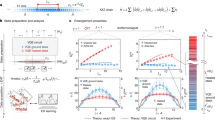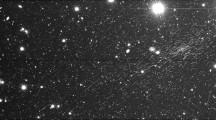Abstract
IN using ionization chambers to study extensive showers, it is necessary to assume some value for the specific ionization of shower particles in order to convert the number of ions collected (which is the quantity measured by the chamber) to the number of particles passing through the chamber, and hence the shower density. There seems to be no general agreement between different workers as to the best figure to assume for this purpose. A survey of the literature reveals that values range from 50 to 100 ion pairs/cm, for air. Many are in the vicinity of 85 ion pairs/cm. for argon, or its equivalent of about 65 ion pairs/cm. for air or nitrogen. This figure corresponds to the specific ionization averaged over electrons of all energies, including those near the minimum of the ionization loss—energy curve. The average energy of extensive shower particles is in the region of 100 MeV., and it therefore seems reasonable to take a larger value for the specific ionization of such particles. Carmichael1 has, in fact, suggested that discrepancies between the extensive shower spectrum obtained by Geiger-counter methods and that found from the size distribution of large bursts could be partly due to an under-estimation of the sizes of bursts in the latter case for the above reason. Carmichael suggests that a value of specific ionization at least 1·4 times greater is necessary to obtain agreement.
Similar content being viewed by others
Article PDF
References
Carmichael, H., Phys. Rev., 74, 1667 (1948).
Corson, D. R., and Brode, R. B., Phys. Rev., 53, 773 (1932).
Sen Gupta, R. L., Nature, 146, 65 (1940).
Hazen, W. E., Phys. Rev., 67, 269 (1945).
Rossi, B., and Greisen, K., Rev. Mod. Phys., 13, 240 (1941).
Author information
Authors and Affiliations
Rights and permissions
About this article
Cite this article
PRESCOTT, J. Specific Ionization of Extensive Shower Particles. Nature 164, 756 (1949). https://doi.org/10.1038/164756a0
Issue date:
DOI: https://doi.org/10.1038/164756a0



